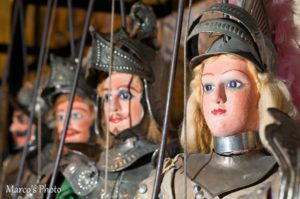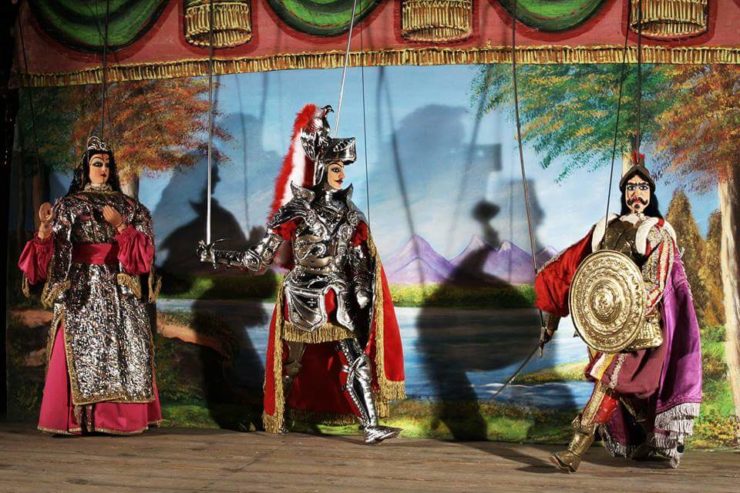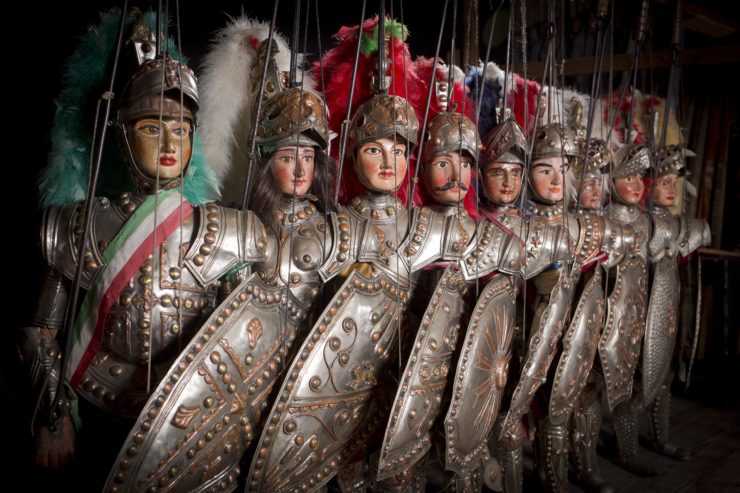The third-grade students in Misterbianco, a small town at the foot of Mount Etna in eastern Sicily, watched, rapt, as the heavy puppets moved on a school auditorium stage. The kids laughed, open their mouths with astonishment, then clapped. When the curtain fell, some sighed, asking for more.
The puppet show was an episode of a Sicilian theater tradition: the opera dei pupi -- literally, puppet’s work. Borrowing from epic novels of the Middle Ages, they’re a once-popular form of oral storytelling about Sicilian history and identity that’s been trying to make a comeback.
With their shining knight armor and unsheathed swords, the puppets can be 4 feet tall and weigh nearly 80 pounds. As opposed to most puppets, which are moved by their masters’ hands from below the stage, Sicilian pupis are animated from above -- in certain cases with their masters onstage, too -- by two metal rods.
“We deleted the long pauses in our storytelling in order to satisfy the modern audience."
The whole show is conducted in Sicilian dialect, in what puppet theaters hope will wrest the Italian island’s speech from the stereotypical role it plays in the 21st century: as the language of the Mafia, which was born in Sicily.
It is no coincidence that the puppet shows, which became popular in the 19th century during the Spanish domination in southern Italy, constitute a humble but tenacious sign of contradiction and resistance, reflecting the typical Sicilian logic of resignation and literature of the "vanquished.” Mostly all the shows are about battles and fights – including the fight for the love of Angelica, the main female character of almost every opera dei pupi show.

In 2008, UNESCO added the opera dei pupi to the Intangible Cultural Heritage Lists, the first Italian heritage ever to be added and among the first 19 to be protected worldwide. But the international recognition didn’t greatly help the mission of bringing the lost audience back.
“Participation started decreasing in the 1960s, with Italian TV entering the market as a new form of entertainment and education,” says Elisa Puleo, head organizer of the Cuticchio Sons of Art Association, founded in the 1970s.
Launched by Mimmo Cuticchio, who’s been dubbed the father of the opera’s rebirth, the association tries to increase the recognition of this art. School shows like the one in Misterbianco are part of a recent initiative to impassion a young and modern audience to this historical form of oral storytelling.
The two most prominent players in this preservation effort are the Napoli family in Catania and the Cuticchio descendants in Palermo. Although the two cities are well-known in Italy for ancient rivalries that still exist today -- and not only on the soccer pitch -- they try to forget that they are competitors and “focus on the shared goal of keeping this tradition alive, for the sake of the opera,” says Fiorenzo Napoli, creative director of Fratelli Napoli’s puppet theater.
They’re trying to update this storytelling art, mixing old characters with new ideas and scaling back its epic length.
In the 19th and 20th centuries, the shows could last a whole cycle of 300 episodes spread over five months. Once a week, the audience would meet at the theater and continue the story where it stopped the time before, like an old version of today’s TV series, but live.
But this approach wouldn’t work for a 21st century audience accustomed to consuming entertainment quickly. So they’re reducing the original number of episodes from 300 to 25, and also trying to attract occasional tourists to spread the gospel abroad.

“We deleted the long pauses in our storytelling in order to satisfy the modern audience,” Puleo said. “But this didn’t totally erase the dramatic suspense typical of this storytelling form; it was just updated to be more accessible.”
Napoli said that his theater was adding new stories to their repertoire, together with the original ones about chivalry -- stories that could attract the attention of modern Sicilians, with themes that could engage them again from an identity standpoint.
“We staged pieces of classical Sicilian social literature, others on the Italian unification from the Sicilian perspective, or conversations about Mafia from Giuseppe Fava, a writer killed by local mobsters,” Napoli said.
Other Sicilian puparis have followed this strategy and have succeeded in attracting both audience and media attention beyond local lands. Angelo Sicilia, another puparo from Palermo, began an opera dei pupi focused on stories about Sicilian resistance against mafia and mobsters. His idea was brought to schools and theaters alike, to educate the new generation on their own history and adapt an old tradition to a contemporary society.
Referring to widespread Italian stereotypes about the Sicilian dialect and region, often unfairly associated with criminality and illiteracy, Puleo said: “To gain back the opera’s dignity – and, with it, Sicilian identity -- we have to put aside the exotic and folkloristic label that has been given to it by the rest of Italy. If we recognize it as a tradition rather than a mocking stereotype, we’ll be able to bring it back to its past glory.”



